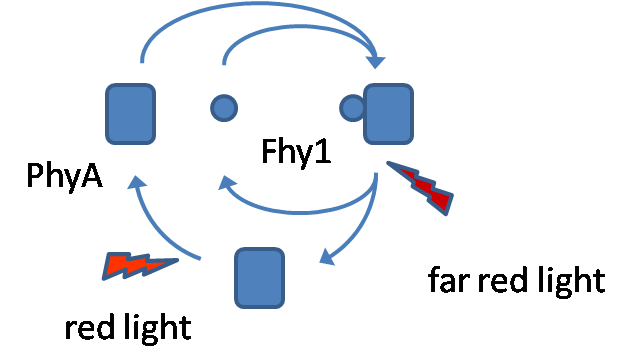Freiburg07/report light sensor
From 2007.igem.org
| Line 4: | Line 4: | ||
<h2>Introduction</h2> | <h2>Introduction</h2> | ||
| - | Phytochrome A (PhyA) is a member of the phytochrome family of red/far-red | + | Phytochrome A (PhyA) is a member of the phytochrome family of red/far-red photoreceptors. These photoreceptors are involved in a wide range of developmental responses in plants. Fhy1 is a protein which binds PhyA under light conditions, enable us to use this protein-protein interaction. In plants Fhy1 is responsable for nuclear accumulation of PhyA in case of light exposure. |
| - | + | ||
| - | responses in plants. Fhy1 is a protein which binds PhyA under light conditions, | + | |
| - | enable us to use this protein-protein interaction. In plants Fhy1 is responsable | + | |
| - | for nuclear accumulation of PhyA in case of light exposure. | + | |
<div style="left"> | <div style="left"> | ||
Revision as of 13:52, 23 October 2007
Contents |
Towards optical signal processing in E. coli
iGEM team Freiburg
Introduction
Phytochrome A (PhyA) is a member of the phytochrome family of red/far-red photoreceptors. These photoreceptors are involved in a wide range of developmental responses in plants. Fhy1 is a protein which binds PhyA under light conditions, enable us to use this protein-protein interaction. In plants Fhy1 is responsable for nuclear accumulation of PhyA in case of light exposure.
Materials and Methods
Cloning of constructs:
PhyA Insert was gained by PCR from plasmid D153ah-phyA using 5´ (5´-TATCGACGAA TTCGCGGCCG CTTCTAGAAA GAGGAGAAAT
TAACTATGTC AGGCTCTAGG CCGAC-3´) and 3´ (5´- AACGATCACT AGTTCCGCCG TGATGGTGAT GGTGGCCTCC GTTATCGAGT TCCACCTCCT TA-3´) primers.
Fhy1 Insert1 was gained by PCR from pGADT7 using 5´ (5´-TATCGACGCT AGCGATTACA TCTATGGGAC TCAGA-3´) and 3´
(5´-AACGATCGGC GCGCCCAGCA TTAGCGTTGA GAAGTAT-3´) primers.
Fhy1 Insert2 was gained by PCR from pGADT7 using 5´ (5´-TATCGACGCT AGCAGTAGTA ATGCTGCTAA GTTTGT-3`) and 3´
(5´-AACGATCGGC GCGCCCAGCA TTAGCGTTGA GAAGTAT-3´) primers.
